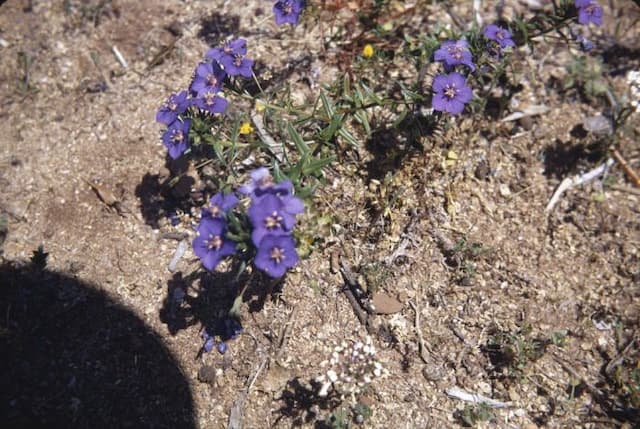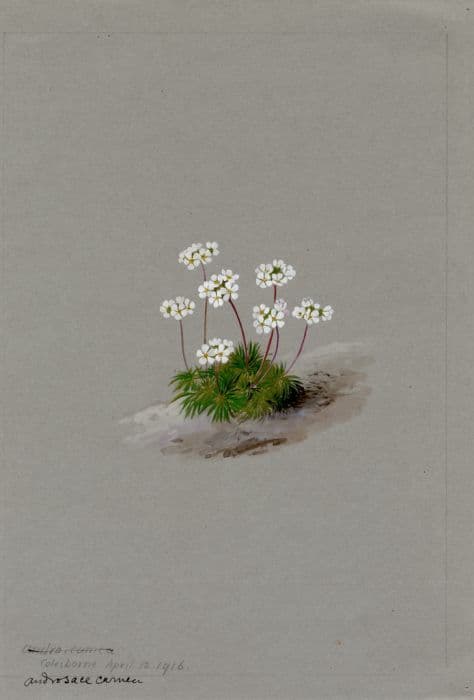Primrose Primula 'Rainbow Blue Shades' (Rainbow Series) (Pr/poly)

ABOUT
The Primula 'Rainbow Blue Shades' from the Rainbow Series is an eye-catching plant known for its vibrant display of blue-toned flowers. The blooms exhibit a range of blue hues, often presenting as a soft pastel blue to deeper rich blues, sometimes accented with hints of purple or a yellow to white center, giving a striking contrast against the blue petals. These flowers typically grow in clusters, creating a lush appearance of color. The foliage of the 'Rainbow Blue Shades' consists of a rosette of leaves at the base, which are lush and green. Leaves are often oval-shaped with somewhat toothed edges, providing a textured appearance. The leaves may also have a slight sheen or a velvety texture contributing to the overall aesthetic of this delightful plant. The contrast between the green leaves and blue blooms makes the 'Rainbow Blue Shades' a particularly attractive choice for gardeners seeking a splash of cool color tones in their garden spaces.
About this plant
 Names
NamesFamily
Primulaceae.
Synonyms
Polyanthus, Primrose.
Common names
Primula 'Rainbow Blue Shades' (Rainbow Series) (Pr/poly).
 Toxicity
ToxicityTo humans
Primrose plants, including the Primula 'Rainbow Blue Shades', are generally considered non-toxic to humans. However, individuals may experience varying degrees of skin irritation or allergic reactions when handling the plant. If ingested, the plant may result in mild stomach upset for some people.
To pets
Primrose, including the Primula 'Rainbow Blue Shades', is generally considered mildly toxic to pets. If ingested, it can potentially cause mild gastrointestinal upset, such as vomiting or diarrhea, in cats and dogs. Symptoms are generally mild and typically do not require intensive medical treatment. However, pet owners should monitor their pets and consult with a veterinarian if signs of distress occur after ingestion.
 Characteristics
CharacteristicsLife cycle
Perennials
Foliage type
Semi-evergreen
Color of leaves
Green
Flower color
Blue
Height
6 inches (15 cm)
Spread
8 inches (20 cm)
Plant type
Herb
Hardiness zones
5
Native area
China
Benefits
 General Benefits
General Benefits- Ornamental Appeal: Adds vibrant blue shades to gardens with its eye-catching blossoms.
- Extended Blooming Period: Offers a long flowering season, typically from late winter through to spring.
- Attracts Pollinators: Invites bees and butterflies to the garden, supporting local ecosystems.
- Low Maintenance: Requires minimal care once established, making it suitable for novice gardeners.
- Compact Growth: Ideal for borders, containers, or small gardens due to its neat growth habit.
- Cold Tolerance: Resistant to lower temperatures, it can thrive in cooler climates and survive frosts.
- Versatility: Suitable for various garden designs including rockeries, alpine gardens, and woodland settings.
 Medical Properties
Medical PropertiesThis plant is not used for medical purposes.
 Air-purifying Qualities
Air-purifying QualitiesThis plant is not specifically known for air purifying qualities.
 Other Uses
Other Uses- Photography Prop: Primula Rainbow Blue Shades can be used by photographers as a subject or backdrop due to its vibrant colors, enhancing the visual appeal of garden and nature-themed photographs.
- Greeting Cards & Botanical Illustrations: The unique appearance of Primula rainbow can be captured in illustrations, making them a beautiful feature for greeting cards and botanical art.
- Fairy Gardens: Due to its colorful and enchanting look, Primula rainbow can be integrated into miniature fairy garden designs, creating a whimsical atmosphere.
- Edible Flower Decoration: The flowers can be used as an edible decoration for salads and desserts, adding color and a mild flavor to culinary creations.
- Education & Research: Primula rainbow can be grown by schools and educational institutions for botanical studies and teaching students about plant life cycles and hybridization.
- Wedding Ceremonies: This plant's vibrant hue can be incorporated into wedding bouquets or venue decorations, evoking a sense of romance and charm.
- Eco-friendly Confetti: The petals of the Primula rainbow can be dried and used as a biodegradable confetti option for celebrations.
- Pressing and Preserving: Craft enthusiasts can press the flowers to create preserved flower art, bookmarks, and other decorative items.
- Seasonal Gift Plants: During flowering season, Primula rainbow can be potted and given as a living seasonal gift that brings cheer during spring.
- Dye Source: The colorful petals could potentially be used as a natural dye source for fabrics, though this will require experimentation to determine colorfastness and vibrancy.
Interesting Facts
 Feng Shui
Feng ShuiThe Primrose is not used in Feng Shui practice.
 Zodiac Sign Compitability
Zodiac Sign CompitabilityThe Primrose is not used in astrology practice.
 Plant Symbolism
Plant Symbolism- Youthfulness: Primulas often symbolize youth due to their early bloom in spring, representing new life and beginnings.
- Hope: With its early flowering, the Primula is seen as a symbol of hope, embodying the optimism that follows the winter months.
- Vitality: The bright colors of the Primula 'Rainbow Blue Shades' express energy and life force, embodying the plant's vivacious nature.
- Renewal: As a herald of spring, this Primula suggests rebirth and the refreshing of the spirit.
- Change: The variety in the Rainbow Series reflects transformation and the embracing of diversity and change.
 Water
WaterThe common polyanthus, including 'Rainbow Blue Shades', prefers consistent moisture, so water the plant when the top inch of soil feels dry to the touch. This usually translates to watering once every 1-2 weeks, but this can vary depending on environmental conditions and the size of the plant and pot. Use room-temperature water and gently pour it at the base of the plant until you see excess water drain from the bottom of the pot, ensuring thorough soil saturation. Avoid overhead watering to reduce the risk of leaf and crown diseases. During active growth, especially in warmer months, you may need to water the plant more frequently, possibly as often as once a week, but always check the soil moisture level first.
 Light
LightPolyanthus, such as 'Rainbow Blue Shades', thrive in bright, indirect light, so place them near a window where they’ll receive ample light but are shielded from the harsh rays of direct sunlight. An east-facing window is a good spot, as it provides some morning sun followed by brightness for the rest of the day. Avoid full shade, as polyanthus need good light levels to flower well.
 Temperature
TemperaturePolyanthus plants like 'Rainbow Blue Shades' prefer cooler temperatures and can generally tolerate temperatures ranging from about 40°F to 75°F. They are most comfortable in temperatures between 50°F and 70°F. Extended exposure to temperatures below 40°F can damage the plant, while temperatures above 75°F may cause stress and affect flowering.
 Pruning
PruningPruning polyanthus 'Rainbow Blue Shades' is generally done to remove spent flowers and improve appearance. Deadhead the faded flowers regularly to encourage new blooms and prevent the plant from putting energy into seed production. Also, prune away any damaged or diseased foliage to maintain plant health. The best time for pruning is immediately after a flush of blooms fades.
 Cleaning
CleaningAs needed
 Soil
SoilThe best soil mix for Primula 'Rainbow Blue Shades' is well-draining, humus-rich, and consistently moist. A combination of peat, loam, and perlite or sand can create this ideal environment. The soil pH should be slightly acidic to neutral, ideally ranging from 5.5 to 7.
 Repotting
RepottingPrimula 'Rainbow Blue Shades' should be repotted every one to two years to replenish nutrients and provide fresh soil. Repotting is best done after the flowering season or in the fall.
 Humidity & Misting
Humidity & MistingPrimula 'Rainbow Blue Shades' prefers moderate to high humidity levels. To thrive, maintaining a humidity range of 50-60% is ideal for this plant.
 Suitable locations
Suitable locationsIndoor
Place in bright, indirect light with high humidity and cool temps.
Outdoor
Plant in partial shade, keep soil moist, and protect from strong winds.
Hardiness zone
4-8 USDA
 Life cycle
Life cyclePrimula 'Rainbow Blue Shades', commonly known as Polyanthus, begins its life cycle with seed germination, which typically occurs in a cool, moist environment. Upon germination, the plant develops a small rosette of leaves close to the soil surface during its vegetative stage. After establishing its foliage, it enters the flowering stage usually in late winter to early spring, producing vibrant blue to violet blooms arranged in clusters. Following pollination, flowers develop into capsules containing numerous tiny seeds. Once mature, these seeds are dispersed into the surrounding environment, which can lead to the establishment of new plants if conditions are suitable. The plant may become dormant during the colder months, particularly in harsher climates, but will resume growth with the return of favorable conditions.
 Propogation
PropogationPropogation time
Early spring
The Primula, known commonly as primrose, is a delightful perennial that can be propagated primarily through division. The best time for this is right after the plant has finished flowering in the spring. To propagate by division, carefully lift the entire plant from the ground with a garden fork, aiming to keep as much of the root system intact as possible. Gently tease the clumps apart with your hands or cut them with a sharp knife, ensuring each new division has a fair amount of roots attached. Replant the divisions immediately, spacing them about 6 to 12 inches (15 to 30 centimeters) apart to give them room to grow. This method is quite straightforward and helps maintain the health and vigor of the main plant while creating new ones for the garden or to share with fellow gardeners.









